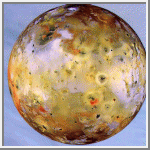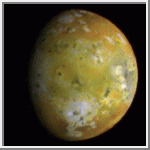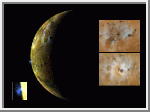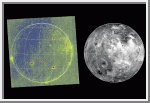 Galileo Images of Io
Galileo Images of Io Galileo Images of Io
Galileo Images of Io
The Galileo spacecraft returned these images of Io.

 Galileo Image of Io
(JPEG, 16K)
Galileo Image of Io
(JPEG, 16K)
The mottled face of Jupiter's volcanically active moon Io,
viewed by the Galileo spacecraft, shows
dramatic changes since it was seen 17 years ago by the exploratory NASA
spacecraft Voyagers 1 and 2.
This image, taken on June 25, 1996 at a
range of 2.24 million kilometers (1.4 million miles), is centered on the Media
Regio area and shows details of the volcanic regions and colored deposits that
characterize Io. North is at the top of the picture and the Sun illuminates the
surface from the east (right). The smallest features that can be discerned here
are approximately 23 kilometers (14 miles) in size.
Io's surface is covered with volcanic deposits that are thought to contain ordinary silicate rock, along with various sulfur-rich compounds that give the satellite its distinctive color. In the brighter areas the surface is coated with frosts of sulfur dioxide. Dark areas are regions of current or recent volcanic activity. Planetary scientists say many changes are evident in the surface markings since this region of Io was imaged 17 years ago by the Voyager spacecraft. The bright regions near the eastern limb of the moon are much more prominent in the Galileo images than they were previously. Surface details have also changed dramatically in the vicinity of the eruptive volcano Masubi (the large, predominantly white feature seen near the 6 o'clock position in this view). Masubi was discovered as an active volcano during the Voyager encounters of Io in 1979. (Courtesy NASA/JPL)
 Io Triplet
(JPEG, 115K)
Io Triplet
(JPEG, 115K)
Three full-disk color views of Jupiter's volcanic moon Io as seen by
NASA's Galileo spacecraft camera are shown
in enhanced color to highlight details of the surface. Comparisons
of these images to those taken by the Voyager
spacecraft 17 years ago has revealed many changes have
occurred on Io. Since that time, about a dozen areas at least as large
as the state of Connecticut have been resurfaced.
These three views, taken by Galileo in late June 1996, show about 75 percent of Io's surface. The images reveal that some areas on Io are truly red, whereas much of the surface is yellow or light greenish. The major red areas shown here appear to be closely associated with very recent fragmental volcanic deposits (pyroclastics) erupted in the form of volcanic plumes. The most prominent red oval surrounds the volcano Pele (far right), as previously discovered by Hubble Space Telescope images. An intense red spot lies near the active plume Marduk east of Pele. Other reddish areas are associated with known hot spots or regions that have changed substantially since the Voyager spacecraft flybys of 1979. The reddish deposits may be the products of high-temperature explosive volcanism.
There are some curious differences in the overlap region between the images at left and center. There are several especially bright areas in the image at left that appear much darker in the image at center. These may represent transient eruptions or surface materials with unusual light-scattering properties.
Several volcanic plumes active during the Voyager flybys in 1979 occurred near the bright limbs or terminator regions of these images, where airborne materials should be detectable. Loki and Amirani appear to be inactive, Volund is active, and Pele may be active but is extremely faint. The plume Marduk also seems to be active, and dark jets of erupting materials can be seen against the disk. Several previously unknown mountains can be seen near the terminators. (Courtesy NASA/JPL)
 Eruption on Io
(JPEG, 58K)
Eruption on Io
(JPEG, 58K)
This image, taken by NASA's Galileo spacecraft, shows a new
blue-colored volcanic plume extending about 100 kilometers (about 60
miles) into space from Jupiter's moon Io (see inset at lower left).
The blue color of the plume is consistent with the presence of sulfur
dioxide gas and "snow" condensing from the gas as the plume expands and
cools. Galileo images have also shown that the Ra Patera plume glows
in the dark, perhaps due to the fluorescence of sulfur and oxygen ions
created by the breaking apart of sulfur dioxide molecules by energetic
particles in the Jovian magnetosphere. The images at right show a
comparison of changes seen near the volcano Ra Patera since the Voyager
spacecraft flybys of 1979 (windows at right show Voyager image at top
and Galileo image at bottom). This eruptive plume is an example of a
new type of volcanic activity discovered during Voyager's flyby in
1979, believed to be geyser-like eruptions driven by sulfur dioxide or
sulfur gas erupting and freezing in Io's extremely tenuous atmosphere.
Volcanic eruptions on Earth cannot throw materials to such high
altitudes.
Ra Patera is the site of dramatic surface changes. An area around the
volcano of about 40,000 square kilometers, area about the size of New
Jersey, has been covered by new volcanic deposits. The image was taken
in late June 28, 1996 from a distance of 972,000 kilometers (604,000
miles).
(Courtesy NASA/JPL)
 Volcanic Hot Spots and Auroral Emisions on Io
(JPEG, 64K)
Volcanic Hot Spots and Auroral Emisions on Io
(JPEG, 64K)
Volcanic hot spots and auroral emissions glow on the
dark side of Jupiter's moon Io in the image at left. The image was taken
by the camera onboard NASA's Galileo spacecraft on 29 June, 1996 UT while
Io was in Jupiter's shadow. It is the best and highest-resolution image
ever acquired of hot spots or auroral features on Io. The mosaic at right
of 1979 Voyager images is shown with an identical scale and projection to
identify the locations of the hot spots seen in the Galileo image. The
grid marks are at 30 degree intervals of latitude and longitude. North is
to the top.
In the nighttime Galileo image, small red ovals and perhaps some small green areas are from volcanic hot spots with temperatures of more than about 700 kelvin (about 1000 degrees Fahrenheit). Greenish areas seen near the limb, or edge of the moon, are probably the result of auroral or airglow emissions of neutral oxygen or sulfur atoms in volcanic plumes and in Io's patchy atmosphere. The image was taken from a range of 1,035,000 kilometers (about 643,000 miles). (Courtesy NASA/JPL)
 Io's Full Disk
(JPEG, 87K)
Io's Full Disk
(JPEG, 87K)
Io, the most volcanic body in the solar system, is
seen in front of Jupiter's cloudy atmosphere in this image from NASA's
Galileo spacecraft, now orbiting the giant planet. This newly processed
image is the best and highest resolution view of Io produced thus far by
Galileo. Galileo was about 487,000 kilometers (about 302,000 miles) from
Io when this was taken on September 7, 1996, and Jupiter was about 908,000
kilometers (about 564,000 miles) away. The image is centered on the side
of Io that always faces away from Jupiter. The color in the image is
composed of data taken in the near-infrared, green and violet filters of
Galileo's solid-state imaging camera, and has been enhanced to emphasize
the extraordinary variations in color and brightness that characterize
Io's volcano-pocked face. The black and bright red materials correspond to
the most recent volcanic deposits, probably no more than a few years old.
The near-infrared filter makes Jupiter's atmosphere look blue. The active
volcano Prometheus is seen near the right-center of the disk. Scientists
are noting many changes that have occurred on Io's surface since the
Voyager flybys 17 years ago, and even a few changes in the two months
since Galileo's imaging of Io this summer.
(Courtesy NASA/JPL)
 Changing Volcanic Activity on Io
(JPEG, 59K)
Changing Volcanic Activity on Io
(JPEG, 59K)
Volcanoes on Jupiter's moon Io are compared in these
images from NASA's Galileo spacecraft (right) taken in early September of
this year, and from the Voyager spacecraft (left) taken in 1979.
Prometheus (bright ring in upper right) was first seen as an erupting
volcano by the Voyager spacecraft and still features an active plume. A
smaller active plume was discovered at the volcano Culann Patera (dark
feature at lower left) by the Galileo spacecraft.
Prometheus has displayed similar characteristics such as size, shape and brightness to Galileo's cameras as it did to Voyager's. However, several intriguing differences are also apparent. There appears to be a new dark lava flow emanating from the vent of Prometheus, and the plume is now erupting from a position about 75 kilometers (46.5 miles) west from where the hot spot resided in 1979. It is not known if the plume source is the same or if the plume is now emanating from a new source. Overall, scientists studying Galileo images of Io see that a wide variety of surface changes have occurred on Io since 1979. The Galileo image was taken at a range of about 487,000 kilometers (about 302,000 miles) from Io. The Voyager image was taken from about 800,000 kilometers (about 500,000 miles). (Courtesy NASA/JPL)
 NIMS Image of Io - First Encounter
(JPEG, 61K)
NIMS Image of Io - First Encounter
(JPEG, 61K)
Io has been imaged by the Near Infrared Mapping
Spectrometer (NIMS) on Galileo. The image on the right shows for the first
time the distribution of volcanic hotspots on the surface of Io, as seen
by NIMS. Three of these hotspots are new discoveries, only detectable with
the NIMS instrument. This image was taken during the First Ganymede encounter on June
29, 1996. The image on the left shows the same view of Io as seen by the
Voyager spacecraft in 1979. At least one dozen hotspots have been
identified from this NIMS image. Most of the hotspot locations can be
matched with volcanic features on the surface of Io, including the vent
area of the active Prometheus plume.
(Courtesy NASA/JPL)
 NIMS Image of Io - Second Encounter
(JPEG, 67K)
NIMS Image of Io - Second Encounter
(JPEG, 67K)
The Near Infrared Mapping Spectrometer (NIMS) on the
Galileo spacecraft imaged Io at high spectral resolution at a range of
439,000 km (275,000 miles) during the second Ganymede encounter on 6 September 1996.
This image shows, on the right, Io as seen by NIMS, centered on 220 W
longitude. The image on the left shows the same view point from Voyager
data (from the encounters in 1979 and 1980). The NIMS image can be
compared to the above NIMS hotspot image (from the First orbit on June 1996) to
monitor changes on Io. The most dramatic feature of this image is the
hotspot at Malik Patera. Preliminary analysis of the data yields a
temperature of at least 1000 K (727 C) for this hotspot, an increase of
more than 300 K from the first encounter. In the overlap area of the first and
second images all the hotspots seen during the first encounter are also seen in
the second image. Other hotspots were seen, including one at the Pele plume
origin site. This image is at the 4 micron band to best view the Malik
hotspot. Most of the other hotspots are best seen at longer wavelengths.
NIMS is continuing to observe Io to monitor volcanic activity throughout
the Galileo mission.
(Courtesy NASA/JPL)
 Image of Ionian Volcano Pele
(JPEG, 21K)
Image of Ionian Volcano Pele
(JPEG, 21K)
These frames detail the changes around Pele on
Io, as seen by Voyager 1 (left), Voyager 2 (middle), and
Galileo (right). The Voyager frames were taken in 1979 when the two
spacecraft flew past Jupiter and it's moon Io. The Galileo view was
obtained in June, 1996. Note the changes in the shape of the deposits
further from the vent while the radial dark features closer to the vent
show little change. The Voyager images use orange, blue, and violet
filters. The Galileo image uses the green and violet filters of the Solid
State Imaging system aboard the Galileo spacecraft and a synthetic blue.
All three images are in a simple cylindrical projection and are
approximately 1700 km x 1500 km. North is to the top. A high-resolution
image of Pele can be found on the
Io page.

